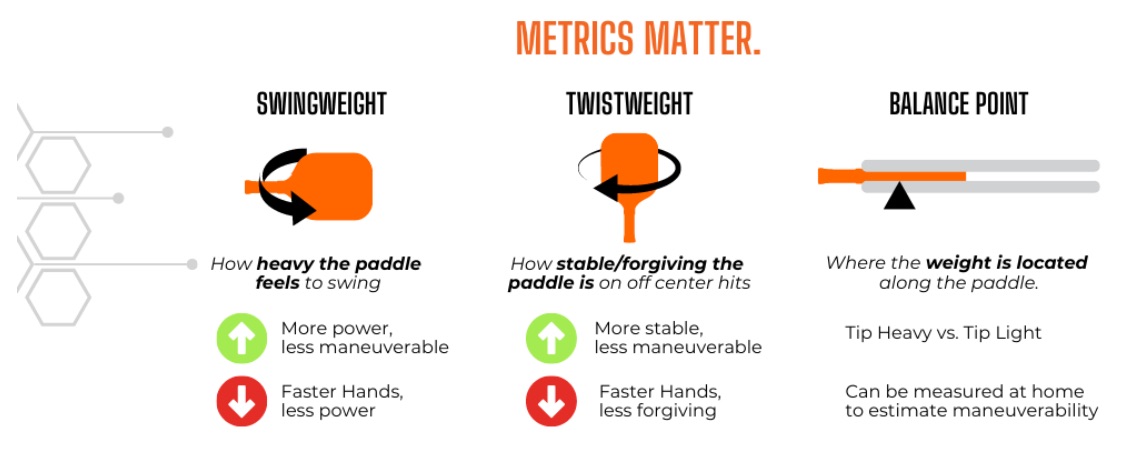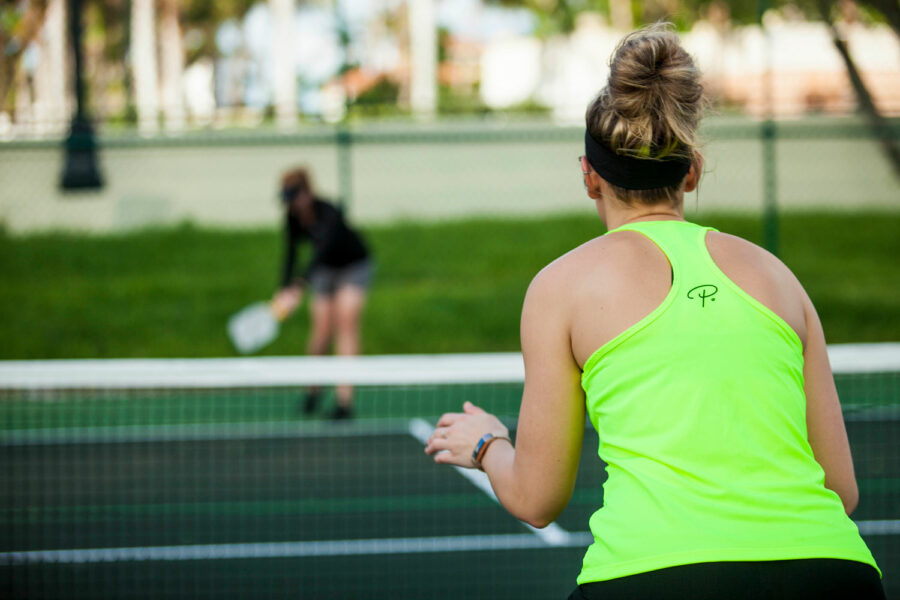As the landscape of pickleball paddle technology evolves, so does the terminology associated with paddle specifications. In previous blog posts, I delved into concepts such as aramids, carbon fiber, Toray 700, and other concepts. With advancements in manufacturing technology, new terms are emerging on manufacturers’ websites, catering to players seeking the perfect paddle for their game. Below, I’ll explore some well-known terms like lightweight, midweight, and heavyweight, with a focus on recreational players rather than those at the elite 5.0 level and above. Then I will explore advanced terminology.
ARAMID
Aramids are man-made fibers with enhanced structural properties, known for their incredible tensile strength. They are used in advanced products where light weight, yet high strength is needed. Aramid fibers are made from long-chain synthetic polyamides.
At the risk of making your head hurt, here is the definition of polyamides: Polyamides are polymers which contain repeating amide, -CO-NH-, linkages. Proteins are examples of naturally occurring polyamides.
Kevlar® is the most well-known of the Aramid fibers, and is the trademarked brand name for the aramid fiber made by DuPont™. Other brands of aramids are Nomex® and Kevlar® (both produced by the DuPont® Company), Tarwon®, Technora®, and Conex® brand fibers. However, due to it being the first para-aramid developed, Kevlar is synonymous with the term aramid.
So, here is a little bit more about Kevlar: Kevlar is a strong, heat-resistant synthetic fiber first used commercially in the early 1970s as a replacement for steel in racing tires.
There is no one type of Kevlar and, in fact, there are many. Here are a few:
- Kevlar 29 – tough yarns for ballistic protection.
- Kevlar K129 – higher tenacity for ballistic applications
- Kevlar K149 – highest tenacity for ballistic, armor, and aerospace applications
- Kevlar AP – 15% higher tensile strength than K-29
- Kevlar XP – lighter weight resin and KM2 plus fiber combination
- Kevlar KM2 – enhanced ballistic resistance for armor applications
CARBON FIBER
Understanding Carbon Fiber and its Impact on Pickleball Paddles
Carbon fiber is a high-performance material composed of thin, strong crystalline filaments of carbon atoms bonded together in long chains. These fibers are renowned for their stiffness, strength, and lightweight properties, making them ideal for creating superior structural materials in various applications.
You may have noticed some paddle manufacturers mentioning the “K” factor of the carbon fiber used in their paddles. This refers to the number of carbon filaments in each tow, which is a bundle of thousands of continuous individual carbon filaments wound onto a reel and held together by an organic coating.
Carbon fiber grades, such as 1K, 2K, 3K, 6K, 12K, 18K, and 24K, indicate the number of filaments per strand. Each grade offers distinct levels of strength and durability, suitable for different uses.
How Does the K Factor Affect Pickleball Paddles?
In pickleball paddles, the K factor significantly influences performance. For example, a 3K fiber face is more loosely wound than fibers with higher K factors. This is akin to stringing a tennis racket: looser strings provide more power. Thus, generally speaking, a paddle with a lower K factor will offer more power, while a higher K factor will result in a paddle with greater control. This is a generalization but has proven to be a reliable observation.
What is an Aramid/Carbon Fiber Hybird?
It is exactly what the name implies – a combination of carbon and Kevlar fabric woven together. Carbon fiber/aramid hybrid material combines the benefits of these two materials to create one super material. The carbon fiber provides high strength and stiffness, while the aramid is good at impact (creating more power) and fracture resistance.
TORAY 700
I have included this as a seperate topic because most paddle manufacturers brag about using Toray 700 on the paddle face. What is it? Toray 700 is a carbon fiber is globally recognized for its outstanding performance, quality, and consistency in processing. There is not mystery to Toray 700 – it is just a carbon fiber. By the way, there are many types of Toray, such as Toray 800, Toray 1100, and so on. Toray 700 is the one most suited for pickleball paddles.
FROSTED CLOTH
This is a new term to me, and I learned about it thanks to Parker Alexander, CEO of The Heartbeat Brand, a company providing pickleball paddles as well as a lot of other types of gear (https://theheartbeatbrand.com). Simply stated, “frosted cloth” is what most Toray 700 carbon fiber paddles have, but not many companies use it as a term. Always good to learn something new.
GRIT
Do you know that there is no mention of grit by the USAPA when it comes to paddle specifications? What it does say is this:
Prohibited Surface Features and Mechanical Features.
• Anti-skid paint or any paint textured with sand, rubber particles, or any material that causes additional spin.
• Rubber and synthetic rubber.
• Sandpaper characteristics.
• Moving parts that can increase head momentum.
So, since there is no mention of what grit is, what is it? Pickleball paddle grit refers to the texture applied to the surface of a pickleball paddle that affects the paddle’s grip on the ball. This grit is essentially a sandy, grainy coating that creates more friction between the ball and the paddle, allowing players to impart greater spin and control during play. Grit comes in various forms including paint grit and added coatings. Paint grit tends to wear off quickly, while added coatings offer more longevity. The best grit offering, though, is seen with raw carbon fiber because it provides a durable and rough surface that enhances the paddle’s spin capabilities.
OTHER TERMINOLOGY
Generally Accepted Terminology
Weight Categories:
- Lightweight: Paddles weighing between 7.0oz and 7.8oz.
- Advantages:
- Ideal for doubles play
- Provides quick hands and speed at the net
- Excellent for shot placement and control
- Disadvantage:
- Generates less power, requiring more effort for powerful drives
- Advantages:
- Midweight: Paddles weighing between 7.8oz and 8.3oz on average.
- Advantages:
- Balanced play style (power and control)
- Increased capability for shot placement
- Suitable for intense exchanges due to added mass
- Disadvantage:
- None identified
- Advantages:
- Heavyweight: Paddles weighing above 8.3oz.
- Advantages:
- Allows for hard-hitting shots with less effort
- Provides stability when returning hard shots
- Disadvantages:
- May cause fatigue in the wrist, arm, and shoulder
- Potential decrease in hand speed at the net
- Advantages:
Advanced Terminology:
Swingweight is a measure of the racket’s resistance to swinging about an axis near the end of the handle. Higher Swingweight has more power but is harder to swing, lower swingweight is easier to swing but has less power. Sometimes a faster swing with a lower swingweight can make up for power lost in swingweight. An easy way to feel a paddle’s swingweight is to grab your paddle in your dominant hand and swing it from side to side. You can then pick up a different paddle and do the same thing. It is likely that you will feel a difference between the two paddles.
Below is a diagram copied from thedinkpickleball.com.

I have a paddle that I really like (no name mentioned) that I decided was head heavy (I knew nothing about swingweight at the time). It weighed 8.2 ounces. To make the paddle more balanced, I added lead weight to the two bottom sides, about .3 ounces in total. That did the trick of making the paddle more balanced, but it also made the paddle heavier. After a few games, my arm started to ache, so I switched to another paddle. The manufacturer had no information about swingweight on its website. Now I will specifically look for that information when investigating paddles.
Twistweight is the resistance to rotating around the long axis through the middle of the paddle from butt to tip. Lower twistweight is easier to maneuver but will twist more on off-center hits, thus losing power and delivering more shock. In other words, twistweight essentially describes the stability of the paddle when the ball is hit outside the center of the face. A paddle with a high twist weight will rotate less when contacted off center resulting in a shot similar to hitting the sweet spot, while one with a lower twist weight will be easier to get into position but more reactive to off-center hits.
Balance Point: The point where there is equal weight on both sides. Knowing a paddle’s balance point can help us understand its maneuverability, which most comes into play when we talk about hand speed.
Below is a great diagram from pickleballcentral.com that sums up these definitions.

Additional Advanced Concepts:
- Dynamic Impact Stiffness: Measures the force required to bend the paddle an inch upon impact, closely associated with “feel.”
- Power Potential (ACOR): Reflects how much incident ball speed remains after bouncing from a stationary paddle, influenced by swingweight, twistweight, and hitting weight.
- Hitting Weight: Indicates the power and shock absorption of the paddle when the ball is struck in the center.
- Static Friction (COFs): Measures friction inhibiting a static ball from sliding across the paddle.
- Vibration Frequency: Indicates paddle stiffness, felt as a buzz in the hand.
Modifying Paddles:
You can always modify your paddles by adding lead tape or, in the case of some other paddles, stick on weights at various places along the paddle. Rather than try to explain how placement affects the paddle, I’ll let the diagram from pckl.com do it for me.

Understanding these terms is crucial for players looking to fine-tune their paddle choices. Manufacturers’ websites may provide valuable information on swingweight, twistweight, and other advanced specifications. Being informed about these concepts ensures that players can make adjustments, such as using lead tape, to customize their paddles for an optimal playing experience.
Let’s hope we start seeing more of these terms on paddle websites.
Other sources of information:




